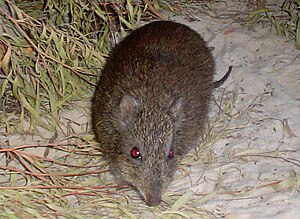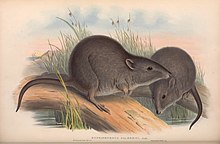Gilbert rabbit kangaroo
| Gilbert rabbit kangaroo | ||||||||||||
|---|---|---|---|---|---|---|---|---|---|---|---|---|

Gilbert Rabbit Kangaroo in Two Peoples Bay |
||||||||||||
| Systematics | ||||||||||||
|
||||||||||||
| Scientific name | ||||||||||||
| Potorous gilbertii | ||||||||||||
| ( Gould , 1841) |
The Gilbert rabbit kangaroo ( Potorous gilbertii ) is a marsupial from the genus of the rabbit kangaroo ( Potorous ). With a population of around 100 specimens, it is one of the rarest mammals in Australia.
features
The males of the Gilbert rabbit kangaroo reach a head-trunk length of 286 to 371 mm, the females from 291 to 343 mm. The tail length is 215 to 232 mm in the males and 200 to 236 mm in the females. The males reach a weight of 1200 g and the females a weight up to 1095 g. Females with young in the pouch weigh up to 1205 g. The top is brown to gray, the underside lighter.
The snout is narrow and slightly curved downwards like other representatives of the rabbit kangaroos. A hairless patch of skin does not extend as far over the snout as in the long-nosed rabbit kangaroo ( Potorous tritactylus ). Dense fur on the sides of the face makes the cheeks appear stronger. The feet are smaller than the head. The Gilbert rabbit kangaroo is smaller than the long-nosed rabbit kangaroo, which reaches a head-torso length of 410 mm and a tail length of 262 mm.
Distribution area and habitat
The Gilbert rabbit kangaroo was once widespread in southwestern Australia and was found in regions around King George Sound and near the Margaret River . Today it is limited to 1000 hectares on the headland of Mount Gardner in the Two Peoples Bay Nature Reserve in Western Australia . It inhabits four separate areas, which consist of unburned, dense bushland. These areas are dominated by shrubs of the species Melaleuca striata and Melaleuca uncinata , which grow 1.5 to 2 m high and have a canopy degree of 70 to 100 percent. The undergrowth is dense with sedge layer covered. The vegetation, which includes grasses of the genera Lepidosperma from the sourgrass family and Anarthria from the Anarthriaceae family , has not been burned for more than 50 years. All specimens of the Gilbert rabbit kangaroo in Two Peoples Bay live in three small colonies in territories between 5 and 15 hectares. These overlap across the board between the sexes.
Eating behavior
The Gilbert rabbit kangaroo is nocturnal. At nightfall it emerges from its nest hidden in the sedge and begins its first activity. It takes a few rest periods during the night before increasing its activity again just before dawn. Like the long-nosed rabbit kangaroo , the Gilbert rabbit kangaroo feeds 90 percent on mushrooms . Spores from over 40 species of fungus have been found in the faeces of the Gilbert rabbit kangaroo. Although some above-ground mushrooms have been found in the diet, the majority of the sporocarps ( fruiting bodies and truffles ) of underground mushrooms make up. Other food components include small invertebrates and the small, fleshy fruits of the genera Billardiera , Leucopogon , Astroloma and Marianthus . The Gilbert rabbit kangaroo recognizes the subterranean sporocarps by their smell and digs them out with its sharp claws.
Reproductive behavior
The Gilbert rabbit kangaroo can reproduce all year round, with mostly two births per year. After around 37 days of gestation, a single cub is born. As with other species of rabbit kangaroos, their birth is delayed due to dormancy . Since the female mates again immediately after the birth of the first embryo, the newly created embryo can grow in the pouch after death or before the old young animal is weaned. The young animal remains in the female's pouch for the first three to four months and, after weaning, leaves the mother's territory between 7 and 18 months of age. Between 60 and 80 percent of young animals do not reach sexual maturity , which begins in females at the age of nine months. The maximum age for both sexes is 10 years.
Natural predators are the New Holland owl ( Tyto novaehollandiae ) and the diamond python ( Morelia spilota ). A far more serious problem, however, is foxes and stray cats.
Discovery, rediscovery and systematics
The Gilbert rabbit kangaroo was discovered in 1840 by John Gilbert , its namesake, and described by John Gould in 1841 . Gilbert sent Gould numerous specimens that were collected by Aborigines in a single afternoon in King George Sound. Additional specimens were collected in 1866 and 1869 by George Masters between King George Sound and the Pallinup River and by William Webb between 1874 and 1879 in the Albany region. From 1909 the species was thought to be extinct and even new searches at the beginning of the 1970s failed. In contrast, subfossil material was discovered in caves in the Margaret River region (e.g. Mammoth Cave, Museum Cave, Brides Cave), at the Leeuwin Naturaliste Ridge and in the Yanchep Caves, which shows that the Gilbert rabbit kangaroo was found in in the past had a much larger area of distribution. For example, the British zoologist Guy Chester Shortridge (1880–1949) found six skulls in caves near the Margaret River in 1906. In 1974 it was officially declared extinct by the IUCN. During field studies of quokkas on Mount Gardner in Two Peoples Bay Reserve in 1994, the zoologist Elizabeth Sinclar finally succeeded in rediscovering the Gilbert rabbit kangaroo after comparing a freshly caught specimen with old museum specimens.
The Gilbert rabbit kangaroo was classified in 1971 by John Henry Calaby (1922-1998) as a subspecies of the long-nosed rabbit kangaroo ( Potorous tridactylus ). However, a study by Sinclair and her colleague Michael Westerman from 1997, in which electrophoresis of the allozyme and DNA sequence analysis of the genes of cytochrome b was performed, showed that P. gilbertii , P. tridactylus and P. longipes were three different Represent lines of development. Although it is most closely related to the long-nosed rabbit kangaroo, it is currently supported for consideration as a distinct species.
status
The Gilbert rabbit kangaroo is classified by the IUCN in the critically endangered category . After the rediscovery of the species, the population was estimated at 30 to 40 specimens. In 1999 a species conservation program was started to increase the population. In the first few years a few young were born, but then there was no breeding success. Reasons for this are to be found in age differences and in balanoposthitis , a disease that affects the penises of male rabbit kangaroos and causes inflammation and ulceration if left untreated. Because of the antibiotics administered, this problem only occurs in wild populations, but not in animals kept in human care.
In 1999, a male Gilbert rabbit kangaroo that was brought into human care with his mother was diagnosed with a disease that caused significant loss of appetite and eventually resulted in death. Within a few weeks, it lost 32 percent of its body weight. It went in circles and behaved oddly. It was also noticed by sporadic coughing fits and shortly before its death it was in a state of hypothermia . When the same symptoms appeared in a long-nosed rabbit kangaroo in 2004, it was found that it was a fatal fungal infection called cryptococcosis , which was caused by the pathogen Cryptococcus neoformans in the Gilbert rabbit kangaroo and the pathogen Cryptococcus gattii in the long-nosed rabbit kangaroo caused. This is possibly a contributing factor to the high death rate in the wild as this infection could kill the young before they reach sexual maturity.
In 2001 an action group was founded to conduct public relations work and raise funds for research and breeding programs in captivity. In August 2005, a conservation breeding program was started on Bald Island . Ten specimens were brought to the gripper-free island between 2005 and 2007. In 2012 the population on Bald Island was 60 specimens. In 2009, six specimens were moved from Bald Island to a 380-acre, fenced-in area in Waychinicup National Park , where the population increased to 20 by 2012.
In 2014, the total population of the Gilbert rabbit kangaroo was estimated at around 100 individuals.
In November 2015, brush fires destroyed 14 hectares (or 90 percent) of critical habitat in Two Peoples Bay.
literature
- Peter Menkhorst: A Field Guide to the Mammals of Australia. Illustrated by Frank Knight. Oxford University Press, South Melbourne et al. 2001, ISBN 0-19-550870-X , p. 108.
- Ronald Strahan & Steve van Dyck (Eds.): The Mammals of Australia. 3rd Revised edition. New Holland Publishers, 2008, ISBN 978-1877069253 , pp. 297-298.
- Andrew Burbidge, John Woinarski, Peter Harrison: The Action Plan for Australian Mammals 2012 Csiro Publishing, 2014. ISBN 978-064-310-873-8 , pp. 318-321
- Jackie Courtenay and Tony Friend for the Gilbert's Potoroo Recovery Team: Gilbert's Potoroo (Potorous gilbertii) Recovery Plan July 2003 - June 2008. Western Australian Wildlife Management Program No. 32, 2004, 38 pp.
- Tony Friend: Rescuing Gilbert's potoroo, the world's most endangered marsupial, with community help. National Wildlife Rehabilitation Conference Proceedings 2007
- Ernie Stead-Richardson, Don Bradshaw, Tony Friend, Terry Fletcher Monitoring reproduction in the critically endangered marsupial, Gilbert's potoroo (Potorous gilbertii): Preliminary analysis of faecal oestradiol-17β, cortisol and progestagens General and Comparative Endocrinology, Volume 165, Issue 1, 1 January 2010: p. 155-162
- Greta J. Frankham, Katherine A. Handasyde, Mark DB Eldridge: Novel insights into the phylogenetic relationships of the endangered marsupial genus Potorous Molecular Phylogenetics and Evolution 64 (2012): p. 592-602
Web links
- Gilbert Rabbit Kangaroo Conservation Program
- Karen McGhee: Back from the dead: Gilbert's potoroo. Conservationists are celebrating the return of an enigmatic marsupial, previously thought extinct. In: Australian Geographic (Issue 108, May-June 2012), accessed July 14, 2015.
- The Western Australian: Rare marsupial fights back from extinction, December 2, 2014, accessed July 14, 2015.
- Potorous gilbertii inthe IUCN Red List of Threatened Species 2015.2. Listed by: T. Friend & A. Burbridge, 2008. Retrieved July 14, 2015.
Individual evidence
- ^ GC Shortridge: An account of the Geographical distribution of the marsupials and monotremes of south-west Australia, having special reference to the specimens collected during the Balston Expedition of 1904-1907. Proceedings of the Zoological Society 55, 1910: 803-848.
- ^ JH Calaby: The current status of Australian Macropodidae. The Australian Zoologist. 16, 1971: 17-29.
- ^ Sinclair, EA & Westerman, M. (1997). Phylogenetic relationships within the genus Potorous (Marsupialia: Potoroidae) based on allozyme electrophoresis and sequence analysis of the cytochrome-b gene. Journal of Mammalian Evolution. 4: 147-161.
- ^ EA Sinclair, AR Murch, M. Di Renzo & M. Palermo: Chromosome morphology in Gilbert's Potoroo, Potorous gilbertii (Marsupialia: Potoroidae). Australian Journal of Zoology, 48, 2000: 281-287
- ↑ Vaughan-Higgins, Rebecca; Buller, Nicky; Friend, J. Anthony; Robertson, Ian; Monaghan, Cree L .; Fenwick, Stan; Warren, Kristin (2011). Balanoposthitis, Dyspareunia, and Treponema in the Critically Endangered Gilbert's Potoroo (Potorous gilbertii) . Journal of Wildlife Diseases 47 (4): 1019-1025. doi : 10.7589 / 0090-3558-47.4.1019
- ↑ Rebecca J. Vaughan, SD Vitali, PA Eden, KL Payne, KS Warren, D. Forshaw, JA Friend, AM Horwitz, C. Main, MB Krockenberger & R. Malik: Cryptococcosis in Gilbert's and long-nosed potoroos Journal of Zoo and Wildlife Medicine 38.4 (2007): 567-73.
- ^ Burbidge, Woinarski & Harrison, 2014, p. 318
- ^ Matthew McDowell: Extinction means more than a loss of species to Australia's delicate ecosystems, February 5, 2016
- ↑ Karen McGhee: Fires send Gilbert's potoroo back to the brink in Australian Geographic, November 25, 2015

